Thursday 20 October 2016
White: B. Sawyer (83) - Black: K. Nevols (134)
1. e4 e5
2. Nf3 Nc6
3. Bc4
The Italian Game, or Guioco Piano, which I defend using the Two Knights defence.
3. .... Nf6
4. d3 Be7
4. .. d5 is considered to be best here but I am not confident with that. I just want to get the king castled.
5. a3
Don't quite understand this.
5. .. O-O
6. O-O
Now I gave some thought to 6. .. d5. As I said, I am not confident opening up the centre in this sort of position, but with my king castled, the centre more defended, and the absence of a white knight on c3, it was quite tempting. 7. exd5 Nxd5 8. Re1 was my main concern. 8. .. Bf6 9. Qe2 Qd6 did not look quite right. White could follow up with 10. Bxd5 Qxd5 11. Nc3.
I also gave thought to 6. .. Re8 but this just seemed to waste time.
Post-match analysis reveals this is fine for Black and that 6. .. d5 is perfectly playable. But I decided to stay solid.
6. .... d6
7. h3
Limiting the scope of the queens bishop. Now I decide it is time to think of a plan. 7. .. Be6 equalises. Instead I decide to advance on the kingside and so need to free and then unpin the f-pawn to do so.
7. ... Ne8
8. Nc3 Kh8
9. b4 a6
10. Ne2
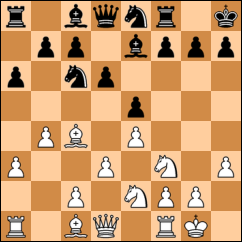
White decides to redeploy the knight to the defence - in effect forcing Black to get on with it. But this is in error as Black now gains the space and initiative. Continuing development with 10. Be3 might have been wiser.
10 ... f5
11. Ng3 f4
12. Ne2 Nf6
13. Nc3 Qe8
White has spent four moves moving one knight back to where it was originally. With the gain in tempi, my plan is now to advance the attack against White's king.
14. d4 Qh5
15. d5
At the time I did not like this move for White which closes down the centre, blocks the bishop, and gives Black a free hand to advance. However it is the choice of the computer who then plans to advance on the queenside with a4, a5 and b5.
15. ... Nd8
Not a good square but the intention is to bring it to f7 and then g5.
16. Be2 Qe8
Now it is my turn to waste time. I considered 16. ... Qg6 but after 17. Nh4 I could not see anything. (17. .. Qg5 18. Nf3).
17. Kh2 Nf7
So back to the knight - maybe it will have more luck.
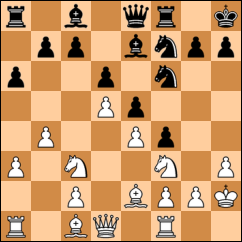
18. Rh1!?
An odd move which was a complete surprise. Maybe 18. g3 is better to challenge Black's advanced pawns. With my last game in mind, I wondered if the plan was to advance the h-pawn at some stage. In fact, it dissuaded me from any thoughts of playing g5-g4.
18. .... Bd7
After a long think, I decided I could not see any way to progress on the kingside and turned my thoughts the other way.
19. Kg1
The drawback with White's plan is that now the rook is entombed. With White struggling with development, I decided the time would be right to open things up a little.
19. ... c6
20. Nd2 cxd5
The first capture of the game takes place on move 20.
21. Nxd5 Nxd5
22. exd5 Rc8
Grabbing the half open file.
23. c4 Bf5
With my pieces now moving to good squares, I was feeling comfortable with the position.
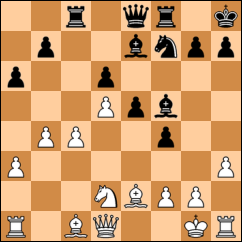
24. Bg4 Qd7
I did not want to take the bishop and open the h-file - again with my last game in mind. I also wanted to keep his rook trapped in the corner and not allow it some freedom by advancing to h3 (for example) and move across to the queenside. However, 24. .. Bxg4 25. hxg4 Nh6 forces 26. f3. But then White can get counterplay with Ne4 and ideas based around a c5 advance.
25. Qe2 Rfe8
To strengthen the e-file defence against a c5 advance.
26. Bb2 Nh6
Putting the question to White. Also my knight was looking at those black squares on e3 and d4 and seeing if it could move to f5 to pressure them.
27. Bh5 Rf8
Instinct told me to dislike 27. .. g6.
28. Rc1 Bf6
29. Ne4 g6
And instinct changed its mind. With my pawns on black squares, it made sense to exchange the black squared bishop.
30. Nxf6 Rxf6
31. Bf3 Qe7
32. Be4 Kg8
To get off the b2 diagonal.
33. f3 Bxe4
34. Qxe4?!
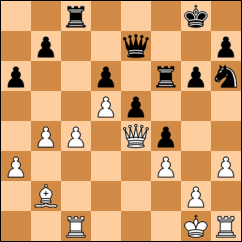
A small mistake. 34. fxe4 solidifies the centre and keeps the knight at bay. Not sure what I would do then while White could start thinking about a queenside offensive.
34. ... Nf5
35. Qe1 Ne3
A wonderful square for the horse and White is under pressure. I now expected 36. Qe2 when I was looking at ideas around 36. ... Nf5 or trying to get the queen on to the a7-g1 diagonal.
36. g3
Instead White sacrifices a pawn.
36. .. Rxc4
Taking with the knight may have been better but I was worried about getting pinned down the c-fie.
37. Rxc4 Nxc4
38. Bc1
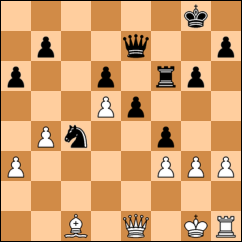
And now 38. .. Qf7 which attacks the d5 pawn and strengthens the f-file pressure is best. Then 39. Qe4 Nb6 40. gxf4 Nxd5. Instead I was focusing on 38. ... fxg3 39. Qxg3 but ...
38 ... fxg3??
.... is a blunder because of ....
39. Bg5
Thud!! From a comfortable position, Black is now fighting to save the draw. I simply did not see this move. Grumbling darkly, I had a long ponder. I'm now going to lose the exchange but, after Qxg3 Nxa3, I will have two pawns for it. He will have weak pawns on h3, f3 and d5. If I can get my queen and knight to buzz around his king, I might be able to force a draw.
Incidentally, the computer rates this position as '-0.56' - it still thinks Black is winning!
39 . Qf7
40. Bxf6 Qxf6
41. Qxg3 Nxa3
I did not consider anything else - but 41. .. Qf7 is an alternative as the d-pawn can't be protected and I get a passed pawn.
42. Kg2?
Better is 42. Kf2 as this walks into a fork.
42. .... Nc2
43. Rc1 Ne3+
44. Kh1 Nxd5
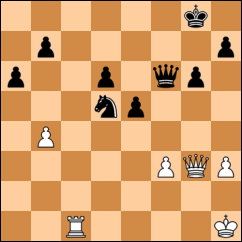
OK, so now I have three pawns for the exchange. The question is - can I hold this position without queens? I decided I could not - I need to attack his weak pawns at the risk of allowing him a combined attack.
45. Rc8+ Kg7
46. Qg4 Kh6
47. Qe4 Qe6
Better would be 47. .. Nf4. If 48. Qxb7 then 48. .. Qf5 would force mate - I did not see that! If 48. Kh2, only then 48. .. Qe6.
48. Qh4+ Kg7
I now expected 49. Qg4. Black should continue to avoid the queen swap with 49. .. Qf7 after which White might try 50. Rd8 with Qc8 to come. I was thinking that if I could get my knight on to the f4 square, then get my queen into the southern half of the board, I should have enough to at least force a draw. Instead it is White's turn to blunder.
49. Kh2??? Qxc8
Thud back! Now the game is won.
50. Qe4 Nf4
51. Kg3 Qxh3+
52. Kf2 Qg2+
53. Ke1 Qg1+
54. Kd2 Qd4+
55. Qxd4 exd4
56. Kd1 h5
57. Resigns
A poor game and a win I did not deserve.
No comments:
Post a Comment